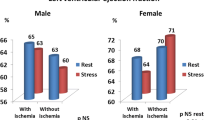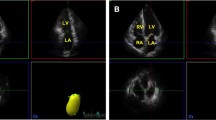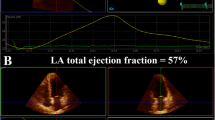Abstract
Background: Stress echocardiography is increasingly used to identify coronary artery disease, but quantitative techniques are required to improve the accuracy of this method. Current algorithms used to analyze wall motion usually neglect motion asynchrony that is found in acute ischemia. Fourier phase imaging of echocardiographic images may offer the possibility to detect asynchrony, but its feasibility with dobutamine stress echocardiography (DSE) is undefined. The aim of this study was to investigate whether the extent of left ventricular asynergy can be used to quantify the severity of regional myocardial dysfunction and to detect functionally significant coronary artery stenoses during DSE. Methods: Regional wall motion abnormalities were induced by graded coronary stenoses (mild and severe) of the left anterior descending coronary artery (LAD) in seven open-chest anesthetized pigs. DSE (10–40 μg/kg/min) was performed under control conditions and during sustained ischemia. Coronary flow was measured under resting conditions and during maximal hyperemic response due to intravenous infusion of adenosine. Functional significance of stenoses was defined as mild when coronary flow reserve (CFR) was reduced but > 1.5 and severe when CFR was ≤ 1.5. Echocardiographic cine loops were mathematically transformed using a first-harmonic Fourier algorithm displaying the sequence of wall motion as phase angles in parametric images and regional phase histograms. The phase difference (PD) of the first Fourier harmonic of posterior vs. anterior myocardial wall motion was calculated as an index of left ventricular asynchrony. Segmental fractional area shortening (FAS) and wall thickening (WT) as ratio of stress to rest served as a reference method of regional wall motion. Results: The increase in FAS (1.62 ± 0.6 vs. 0.42 ± 0.2, p = 0.0002) and WT (1.92 ± 0.5 to 0.3 ± 1.1; p = 0.004) in anterior regions during DSE was significantly higher in the control group compared to severe ischemia but not compared to mild ischemia. During graded ischemia, profiles of phase angles were consistently modified, showing a delayed onset in regional contraction. The mean PD during DSE in the control group was 10.4 ± 7°. PD rose in mild ischemic segments (CFR>1.5) to 28.9 ± 10° (p = 0.003) and to 89.6 ± 25° (p = 0.0002) in severely ischemic segments (CFR ≤ 1.5). There was a significant inverse correlation between the PDs and WT (r = −0.87, p < 0.0001). Normal WT ratios yielded low phase angles while segmental phase angles increased with decreased WT. The intraobserver variability of phase analysis was 2.7 ± 24° (mean ± 2SD). Conclusions: These results suggest that left ventricular asynchrony is an indicator of acute ischemia. Echocardiographic Fourier phase imaging is feasible to quantify wall motion displaying contraction sequence in a simple and objective format and is a␣promising approach for the clinical interpretation of stress echocardiograms.
Similar content being viewed by others
References
Sawada SG, Segar DS, Ryan T, et al. Echocardiographic detection of coronary artery disease during dobutamine infusion. Circulation 1991; 83: 1605–1614.
Hoffmann R, Lethen H, Marwick T, et al. Analysis of interinstitutional observer agreement in interpretation of dobutamine stress echocardiograms. J Am Coll Cardiol 1996; 27: 330–336.
Moynihan PF, Parisi AF, Feldman CL. Quantitative detection of regional left ventricular contraction abnormalities by two-dimensional echocardiography. I. Analysis of methods. Circulation 1981; 63: 752–760.
Lang RM, Vignon P, Weinert L, et al. Echocardiographic quantification of regional left ventricular wall motion with color kinesis. Circulation 1996; 93: 1877–1885.
Fujino T, Ono S, Murata K, et al. New method of on-line quantification of regional wall motion with automated segmental motion analysis. J Am Soc Echocardiogr 2001; 14: 892–901.
Tyberg JV, Parmley WW, Sonnenblick EH. In vitro studies of myocardial asynchrony and regional hypoxia. Circ Res 1996; 25: 569–579.
Heusch G, Guth BD, Widmann T, Peterson KL, Ross J Jr. Ischemic myocardial dysfunction assessed by temporal Fourier transform of regional myocardial wall thickening. AmHeart J 1987; 113: 116–124.
Jamal F, Kukulski T, D'hooge J, De Scheerder I, Sutherland G. Abnormal postsystolic thickening in acutely ischemic myocardium during coronary angioplasty: a velocity, strain, and strain rate doppler myocardial imaging study. J AmSoc Echocardiogr 1999; 12(11): 994–996.
Rose J, Schulz R, Martin C, Heusch G. Post-ejection wall thickening as a marker of successful short term hibernation. Cardiovasc Res 1993; 27: 1306–1311.
TakayamaM, Norris RM, Brown MA, Armiger LC, Rivers JT, White HD. Postsystolic shortening of acutely ischemic canine myocardium predicts early and late recovery of function after coronary artery perfusion. Circulation 1988; 78: 994–1007.
von Bibra H, Tuchnitz A, Klein A, Schneider J, Schoemig A, Schwaiger M. Regional diastolic function by pulsed Doppler myocardial mapping for the detection of left ventricular ischemia during pharmacological stress testing. J AmColl Cardiol 2000; 36: 444–452.
Ratib O, Henze E, Schon H, Schelbert HR. Phase analysis of radionuclide ventriculogramfor detection of coronary artery disease. AmHeart J 1982; 104: 1–12.
Lyons J, Norell M, Gardener J, Davies S, Balcon R, Layton C. Phase and amplitude analysis of exercise digital left ventriculograms in patients with coronary disease. Br Heart J 1998; 62: 102–111.
Lyons J, Norell M, Gardener J, Balcon R, Layton C. The demonstration of exercise induced myocardial ischemia using phase and amplitude analysis of exercise digital left ventriculograms. Eur Heart J 1987; 8(Suppl G): 137–141.
Kuecherer HF, Schoels W, Stems LD, et al. Echocardiographic Fourier phase and amplitude imaging for quantification of ischemic regional wall asynergy: an experimental study using coronary microembolization in dogs. J Am Coll Cardiol 1995; 25: 1436–1444.
Hansen A, Krueger C, Hardt S, Haass M, Kuecherer H. Echocardiographic quantification of left ventricular asynergy in coronary artery disease with Fourier phase imaging. Int J Card Imaging 2001; 17: 81–88.
Kuecherer HF, Abbott JA, Botvinick EH, et al. Two-dimensional echocardiographic phase analysis: its potential for noninvasive localization of accessory pathways in patients with the WPW syndrome. Circulation 1992; 85: 130–142.
Kuecherer HF, Kleber GS, Melichercik J, et al. Transesophageal echo phase imaging for localizing accessory pathways during adenosine-induced preexcitition in patients with the Wolff–Parkinson–White syndrome. Am J Cardiol 1996; 77: 64–71.
Tyberg JV, Parmley WW, Sonnenblick EH. In vitro studies of myocardial asynchrony and regional hypoxia. Circ Res 1996; 25: 569–579.
Pierard LA, De Landsheere CM, Berthe C, Rigo P, Kulbertus HE. Identification of viable myocardium by echocardiography during dobutamine infusion in patients with myocardial infarction after thrombolytic therapy: comparison with positron emission tomography. J Am Coll Cardiol 1990; 15: 1021–1031.
Poldermans D, Arnese M, Fioretti PM, et al. Sustained prognostic value of dobutamine stress echocardiography for 114 late cardiac events after major noncardiac vascular surgery. Circulation 1997; 95: 53–58.
Akaishi M, Schneider RM, Mercier RJ, Agarwal JB, Helfant RH, Weintraub WS. Analysis of phases of contraction during graded acute myocardial ischemia. Am J Physiol 1986; 250: H778–H785.
Tennant R, Wiggers CJ. The effect of coronary occlusion on myocardial contraction. Am J Physiol 1935; 112: 351–361.
Derumeaux G, Ovize M, Loufoua J, et al. Doppler tissue imaging quantitates regional wall motion during myocardial ischemia and reperfusion. Circulation 1998; 19: 1970–1977.
Lee VW, Getcheil J, Foster JE, Salzman L, Plehn J. Rotational artifact in phase imaging of cardiac scans: potential pitfalls in diagnosis. J Nucl Med 1987; 28: 1536–1539.
Author information
Authors and Affiliations
Rights and permissions
About this article
Cite this article
Hansen, A., Hardt, S.E., Pekrul, I. et al. Detection of acute myocardial ischemia during pharmacological stress in graded coronary artery stenosis: analysis of left ventricular asynchrony using Fourier phase imaging in pigs. Int J Cardiovasc Imaging 19, 107–115 (2003). https://doi.org/10.1023/A:1022807406572
Issue Date:
DOI: https://doi.org/10.1023/A:1022807406572




